Guidelines for School Library Media Program Policy Manual Development
VerifiedAdded on 2023/06/09
|7
|1451
|433
Report
AI Summary
This report presents a comprehensive overview of developing a school library program policy manual, emphasizing its role in facilitating learning and fostering information literacy. It highlights the importance of aligning the manual with the American Association of School Librarians (AASL) guidelines to transform teaching and learning environments. Key components discussed include staffing considerations, learning space design, budget allocation, collection and information access strategies, and community outreach initiatives. The manual serves as a guide for librarians and program staff, ensuring equitable learning opportunities and continuous improvement in library services, supported by adequate funding and responsive adaptation to the evolving educational landscape. The report concludes by stressing the library's crucial role in connecting students, teachers, and the broader community to expand knowledge and promote lifelong learning, particularly in the digital age.
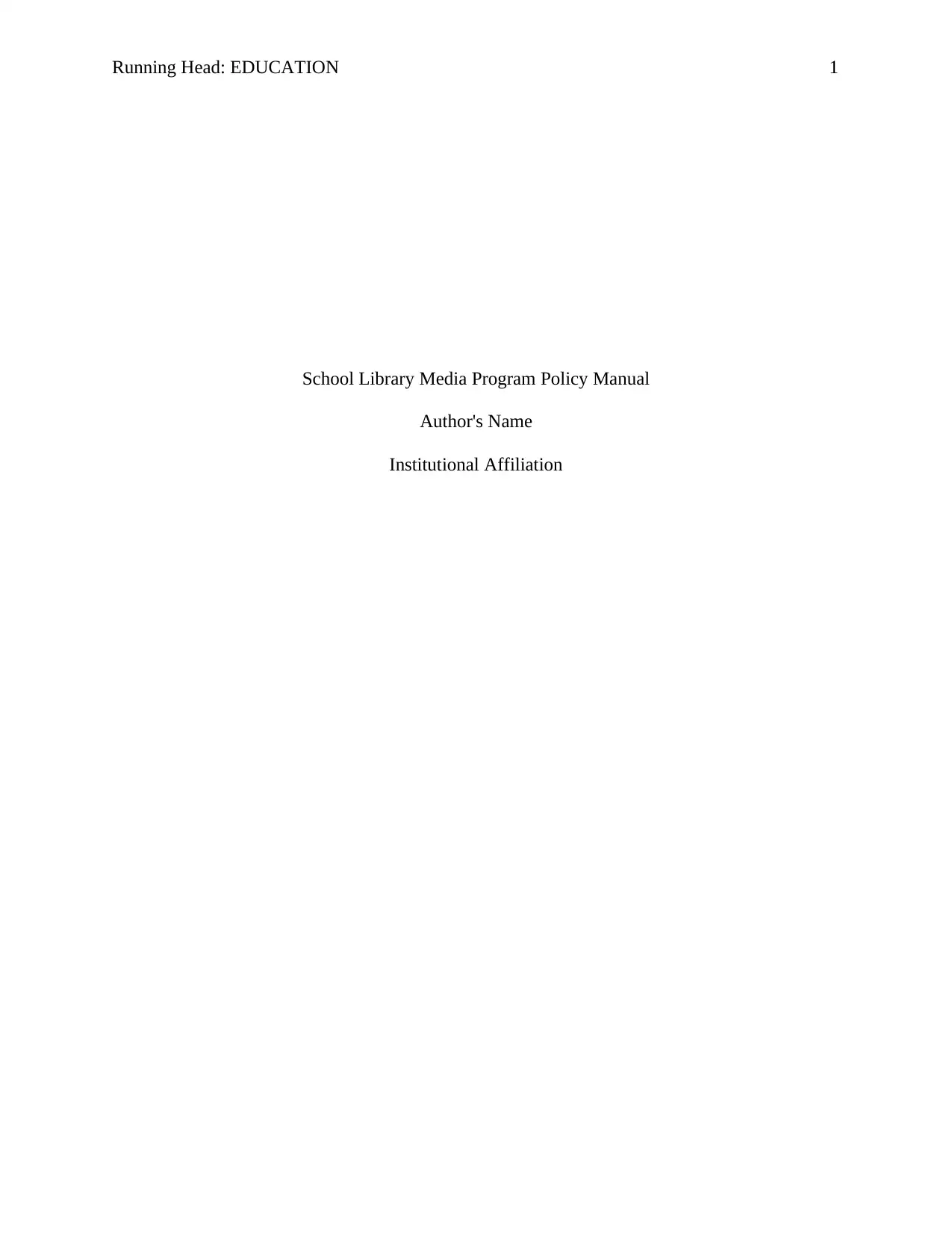
Running Head: EDUCATION 1
School Library Media Program Policy Manual
Author's Name
Institutional Affiliation
School Library Media Program Policy Manual
Author's Name
Institutional Affiliation
Paraphrase This Document
Need a fresh take? Get an instant paraphrase of this document with our AI Paraphraser
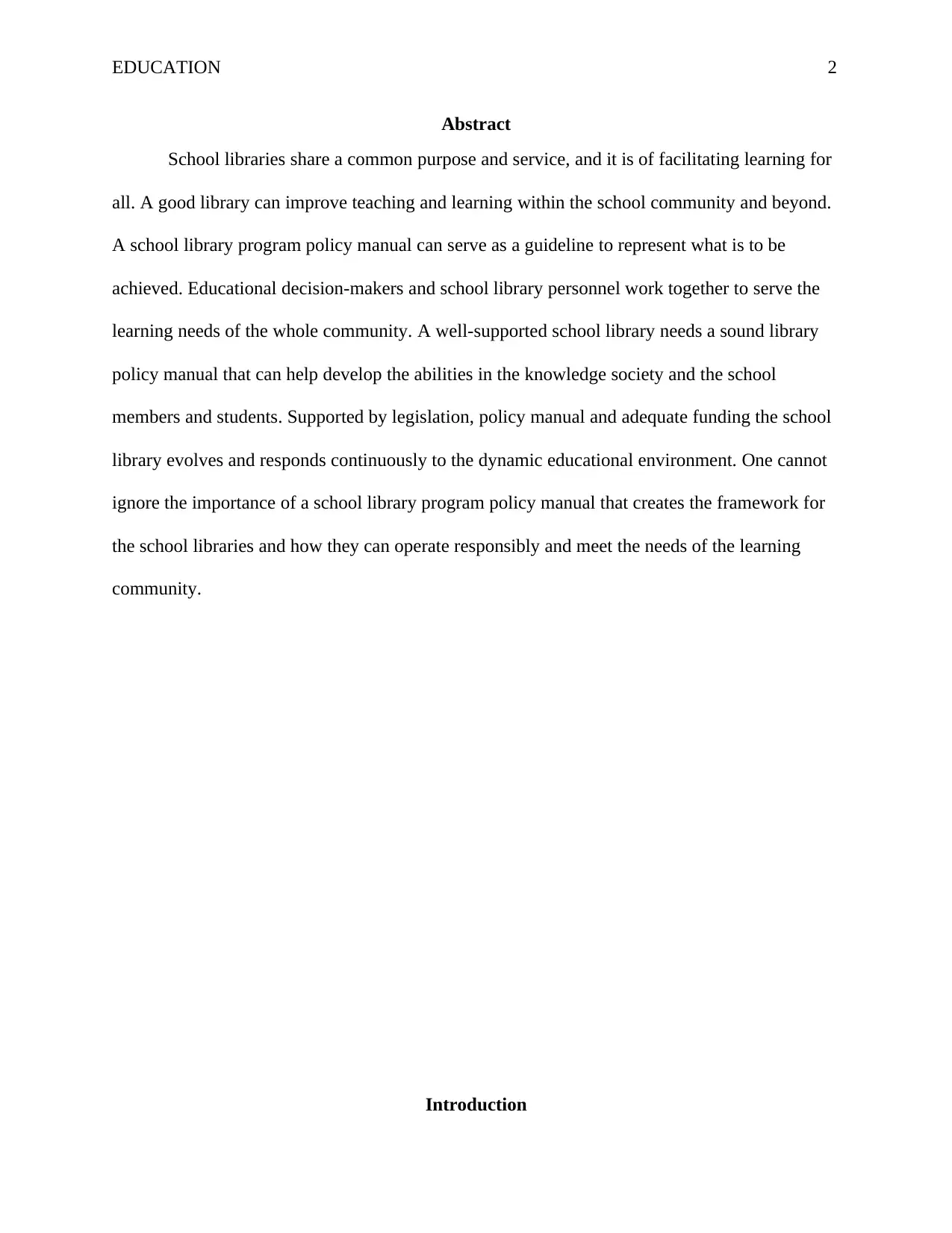
EDUCATION 2
Abstract
School libraries share a common purpose and service, and it is of facilitating learning for
all. A good library can improve teaching and learning within the school community and beyond.
A school library program policy manual can serve as a guideline to represent what is to be
achieved. Educational decision-makers and school library personnel work together to serve the
learning needs of the whole community. A well-supported school library needs a sound library
policy manual that can help develop the abilities in the knowledge society and the school
members and students. Supported by legislation, policy manual and adequate funding the school
library evolves and responds continuously to the dynamic educational environment. One cannot
ignore the importance of a school library program policy manual that creates the framework for
the school libraries and how they can operate responsibly and meet the needs of the learning
community.
Introduction
Abstract
School libraries share a common purpose and service, and it is of facilitating learning for
all. A good library can improve teaching and learning within the school community and beyond.
A school library program policy manual can serve as a guideline to represent what is to be
achieved. Educational decision-makers and school library personnel work together to serve the
learning needs of the whole community. A well-supported school library needs a sound library
policy manual that can help develop the abilities in the knowledge society and the school
members and students. Supported by legislation, policy manual and adequate funding the school
library evolves and responds continuously to the dynamic educational environment. One cannot
ignore the importance of a school library program policy manual that creates the framework for
the school libraries and how they can operate responsibly and meet the needs of the learning
community.
Introduction
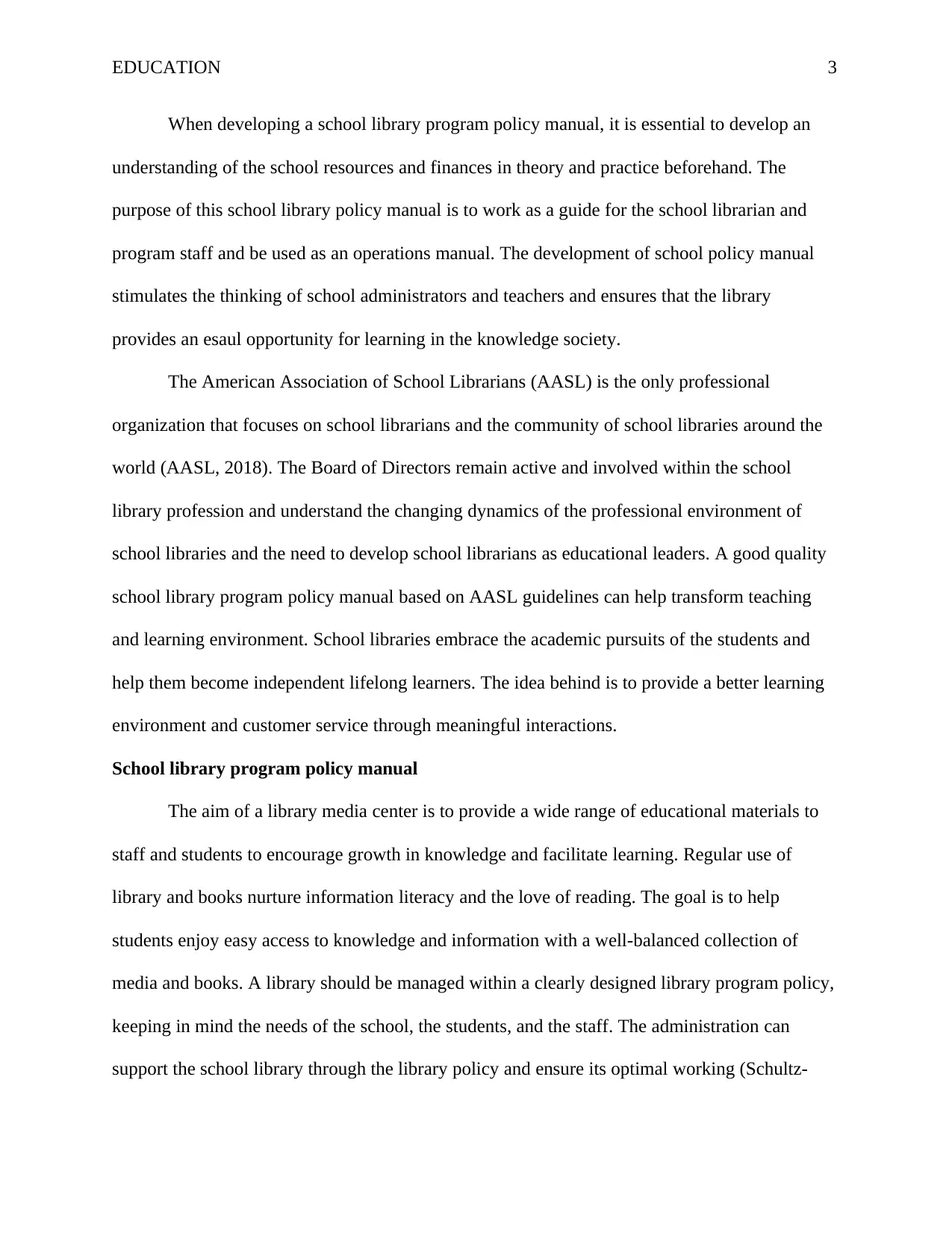
EDUCATION 3
When developing a school library program policy manual, it is essential to develop an
understanding of the school resources and finances in theory and practice beforehand. The
purpose of this school library policy manual is to work as a guide for the school librarian and
program staff and be used as an operations manual. The development of school policy manual
stimulates the thinking of school administrators and teachers and ensures that the library
provides an esaul opportunity for learning in the knowledge society.
The American Association of School Librarians (AASL) is the only professional
organization that focuses on school librarians and the community of school libraries around the
world (AASL, 2018). The Board of Directors remain active and involved within the school
library profession and understand the changing dynamics of the professional environment of
school libraries and the need to develop school librarians as educational leaders. A good quality
school library program policy manual based on AASL guidelines can help transform teaching
and learning environment. School libraries embrace the academic pursuits of the students and
help them become independent lifelong learners. The idea behind is to provide a better learning
environment and customer service through meaningful interactions.
School library program policy manual
The aim of a library media center is to provide a wide range of educational materials to
staff and students to encourage growth in knowledge and facilitate learning. Regular use of
library and books nurture information literacy and the love of reading. The goal is to help
students enjoy easy access to knowledge and information with a well-balanced collection of
media and books. A library should be managed within a clearly designed library program policy,
keeping in mind the needs of the school, the students, and the staff. The administration can
support the school library through the library policy and ensure its optimal working (Schultz-
When developing a school library program policy manual, it is essential to develop an
understanding of the school resources and finances in theory and practice beforehand. The
purpose of this school library policy manual is to work as a guide for the school librarian and
program staff and be used as an operations manual. The development of school policy manual
stimulates the thinking of school administrators and teachers and ensures that the library
provides an esaul opportunity for learning in the knowledge society.
The American Association of School Librarians (AASL) is the only professional
organization that focuses on school librarians and the community of school libraries around the
world (AASL, 2018). The Board of Directors remain active and involved within the school
library profession and understand the changing dynamics of the professional environment of
school libraries and the need to develop school librarians as educational leaders. A good quality
school library program policy manual based on AASL guidelines can help transform teaching
and learning environment. School libraries embrace the academic pursuits of the students and
help them become independent lifelong learners. The idea behind is to provide a better learning
environment and customer service through meaningful interactions.
School library program policy manual
The aim of a library media center is to provide a wide range of educational materials to
staff and students to encourage growth in knowledge and facilitate learning. Regular use of
library and books nurture information literacy and the love of reading. The goal is to help
students enjoy easy access to knowledge and information with a well-balanced collection of
media and books. A library should be managed within a clearly designed library program policy,
keeping in mind the needs of the school, the students, and the staff. The administration can
support the school library through the library policy and ensure its optimal working (Schultz-
⊘ This is a preview!⊘
Do you want full access?
Subscribe today to unlock all pages.

Trusted by 1+ million students worldwide
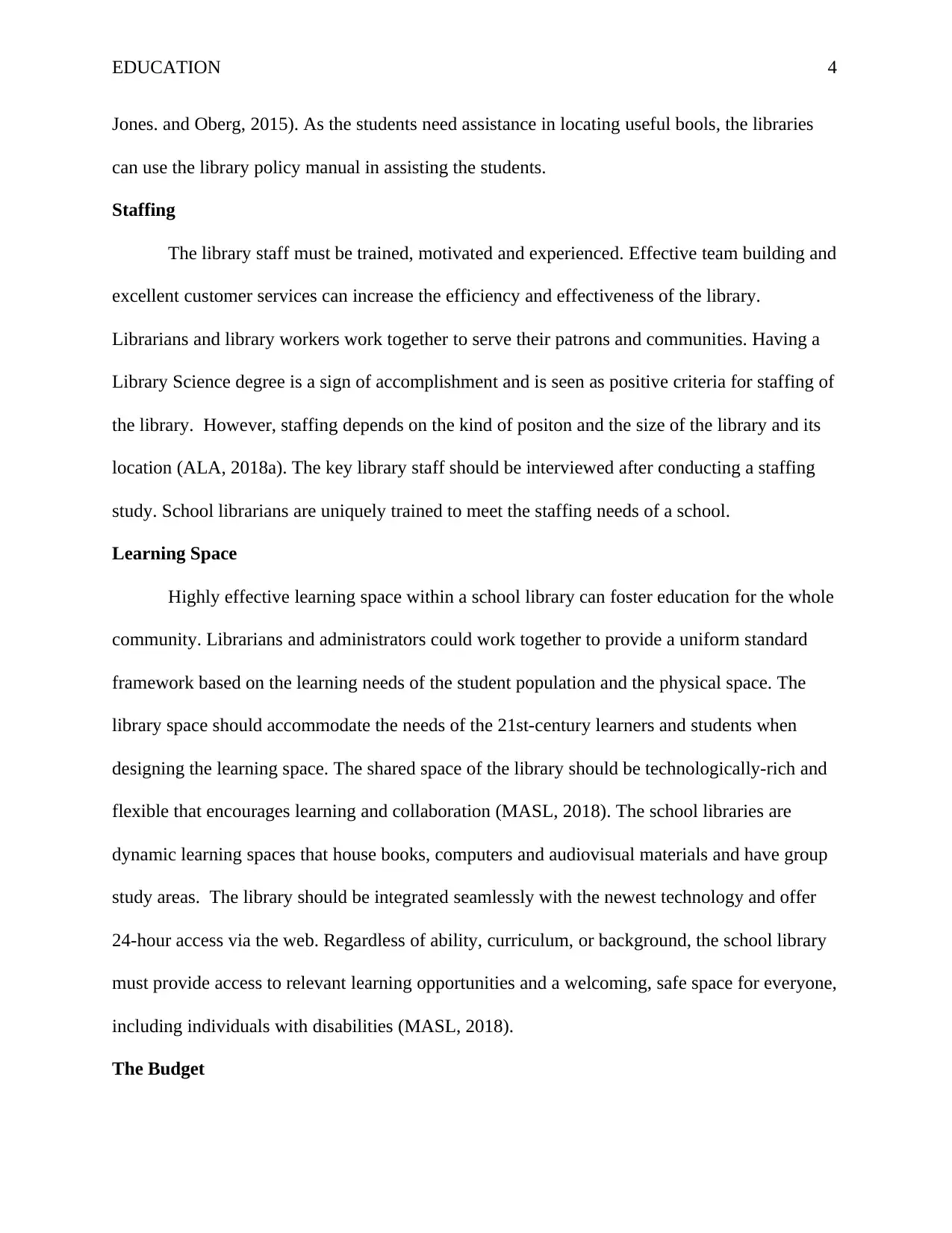
EDUCATION 4
Jones. and Oberg, 2015). As the students need assistance in locating useful bools, the libraries
can use the library policy manual in assisting the students.
Staffing
The library staff must be trained, motivated and experienced. Effective team building and
excellent customer services can increase the efficiency and effectiveness of the library.
Librarians and library workers work together to serve their patrons and communities. Having a
Library Science degree is a sign of accomplishment and is seen as positive criteria for staffing of
the library. However, staffing depends on the kind of positon and the size of the library and its
location (ALA, 2018a). The key library staff should be interviewed after conducting a staffing
study. School librarians are uniquely trained to meet the staffing needs of a school.
Learning Space
Highly effective learning space within a school library can foster education for the whole
community. Librarians and administrators could work together to provide a uniform standard
framework based on the learning needs of the student population and the physical space. The
library space should accommodate the needs of the 21st-century learners and students when
designing the learning space. The shared space of the library should be technologically-rich and
flexible that encourages learning and collaboration (MASL, 2018). The school libraries are
dynamic learning spaces that house books, computers and audiovisual materials and have group
study areas. The library should be integrated seamlessly with the newest technology and offer
24-hour access via the web. Regardless of ability, curriculum, or background, the school library
must provide access to relevant learning opportunities and a welcoming, safe space for everyone,
including individuals with disabilities (MASL, 2018).
The Budget
Jones. and Oberg, 2015). As the students need assistance in locating useful bools, the libraries
can use the library policy manual in assisting the students.
Staffing
The library staff must be trained, motivated and experienced. Effective team building and
excellent customer services can increase the efficiency and effectiveness of the library.
Librarians and library workers work together to serve their patrons and communities. Having a
Library Science degree is a sign of accomplishment and is seen as positive criteria for staffing of
the library. However, staffing depends on the kind of positon and the size of the library and its
location (ALA, 2018a). The key library staff should be interviewed after conducting a staffing
study. School librarians are uniquely trained to meet the staffing needs of a school.
Learning Space
Highly effective learning space within a school library can foster education for the whole
community. Librarians and administrators could work together to provide a uniform standard
framework based on the learning needs of the student population and the physical space. The
library space should accommodate the needs of the 21st-century learners and students when
designing the learning space. The shared space of the library should be technologically-rich and
flexible that encourages learning and collaboration (MASL, 2018). The school libraries are
dynamic learning spaces that house books, computers and audiovisual materials and have group
study areas. The library should be integrated seamlessly with the newest technology and offer
24-hour access via the web. Regardless of ability, curriculum, or background, the school library
must provide access to relevant learning opportunities and a welcoming, safe space for everyone,
including individuals with disabilities (MASL, 2018).
The Budget
Paraphrase This Document
Need a fresh take? Get an instant paraphrase of this document with our AI Paraphraser
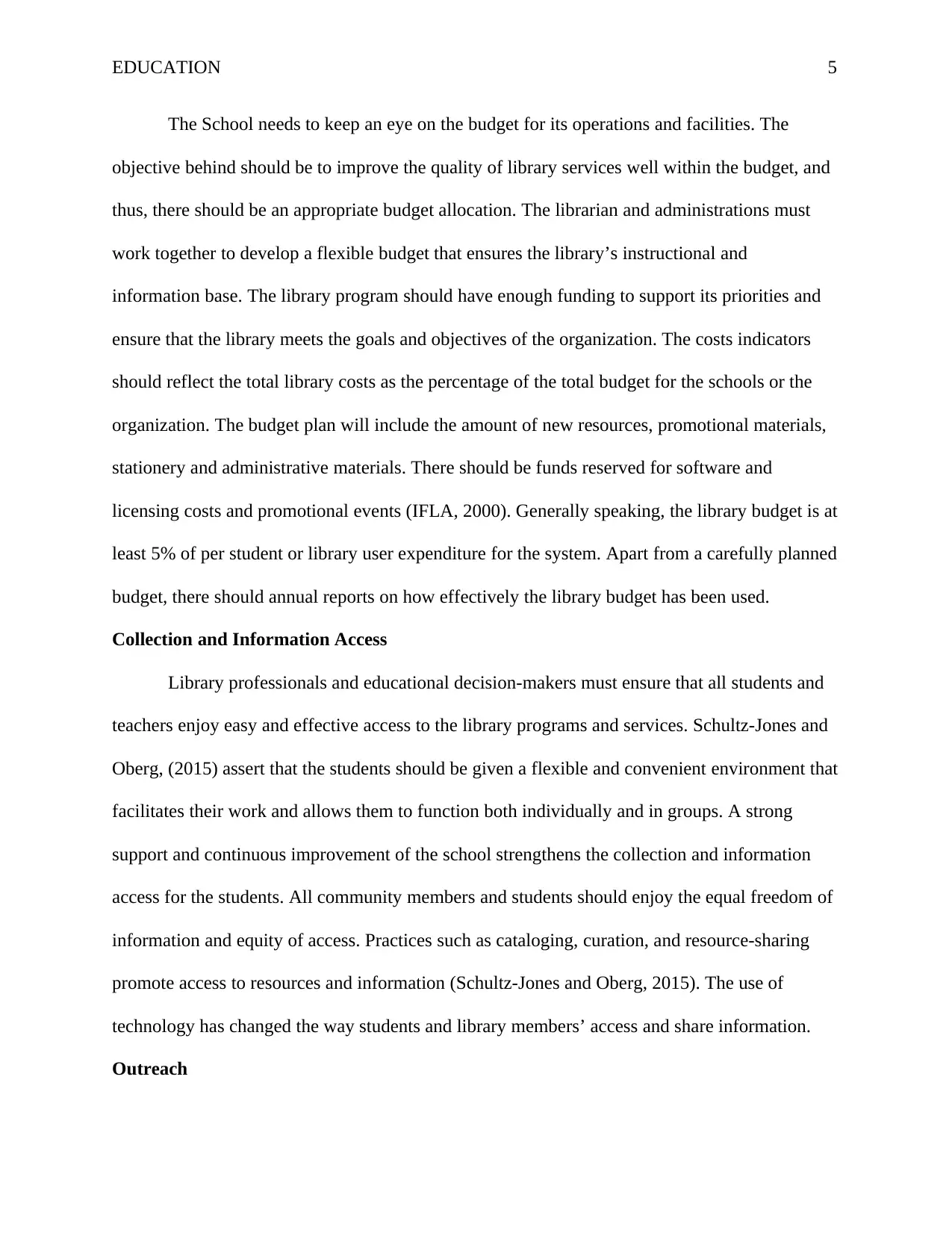
EDUCATION 5
The School needs to keep an eye on the budget for its operations and facilities. The
objective behind should be to improve the quality of library services well within the budget, and
thus, there should be an appropriate budget allocation. The librarian and administrations must
work together to develop a flexible budget that ensures the library’s instructional and
information base. The library program should have enough funding to support its priorities and
ensure that the library meets the goals and objectives of the organization. The costs indicators
should reflect the total library costs as the percentage of the total budget for the schools or the
organization. The budget plan will include the amount of new resources, promotional materials,
stationery and administrative materials. There should be funds reserved for software and
licensing costs and promotional events (IFLA, 2000). Generally speaking, the library budget is at
least 5% of per student or library user expenditure for the system. Apart from a carefully planned
budget, there should annual reports on how effectively the library budget has been used.
Collection and Information Access
Library professionals and educational decision-makers must ensure that all students and
teachers enjoy easy and effective access to the library programs and services. Schultz-Jones and
Oberg, (2015) assert that the students should be given a flexible and convenient environment that
facilitates their work and allows them to function both individually and in groups. A strong
support and continuous improvement of the school strengthens the collection and information
access for the students. All community members and students should enjoy the equal freedom of
information and equity of access. Practices such as cataloging, curation, and resource-sharing
promote access to resources and information (Schultz-Jones and Oberg, 2015). The use of
technology has changed the way students and library members’ access and share information.
Outreach
The School needs to keep an eye on the budget for its operations and facilities. The
objective behind should be to improve the quality of library services well within the budget, and
thus, there should be an appropriate budget allocation. The librarian and administrations must
work together to develop a flexible budget that ensures the library’s instructional and
information base. The library program should have enough funding to support its priorities and
ensure that the library meets the goals and objectives of the organization. The costs indicators
should reflect the total library costs as the percentage of the total budget for the schools or the
organization. The budget plan will include the amount of new resources, promotional materials,
stationery and administrative materials. There should be funds reserved for software and
licensing costs and promotional events (IFLA, 2000). Generally speaking, the library budget is at
least 5% of per student or library user expenditure for the system. Apart from a carefully planned
budget, there should annual reports on how effectively the library budget has been used.
Collection and Information Access
Library professionals and educational decision-makers must ensure that all students and
teachers enjoy easy and effective access to the library programs and services. Schultz-Jones and
Oberg, (2015) assert that the students should be given a flexible and convenient environment that
facilitates their work and allows them to function both individually and in groups. A strong
support and continuous improvement of the school strengthens the collection and information
access for the students. All community members and students should enjoy the equal freedom of
information and equity of access. Practices such as cataloging, curation, and resource-sharing
promote access to resources and information (Schultz-Jones and Oberg, 2015). The use of
technology has changed the way students and library members’ access and share information.
Outreach
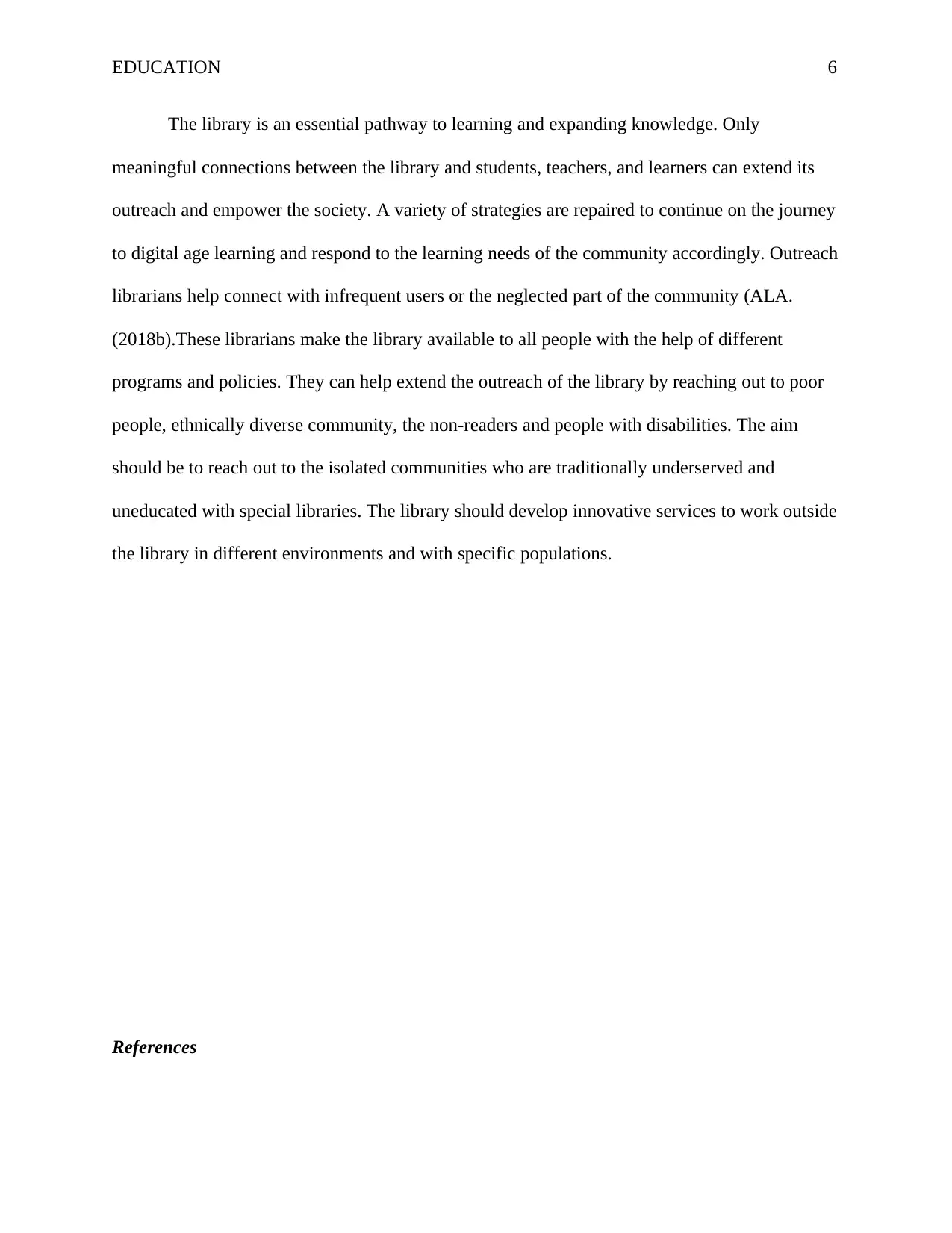
EDUCATION 6
The library is an essential pathway to learning and expanding knowledge. Only
meaningful connections between the library and students, teachers, and learners can extend its
outreach and empower the society. A variety of strategies are repaired to continue on the journey
to digital age learning and respond to the learning needs of the community accordingly. Outreach
librarians help connect with infrequent users or the neglected part of the community (ALA.
(2018b).These librarians make the library available to all people with the help of different
programs and policies. They can help extend the outreach of the library by reaching out to poor
people, ethnically diverse community, the non-readers and people with disabilities. The aim
should be to reach out to the isolated communities who are traditionally underserved and
uneducated with special libraries. The library should develop innovative services to work outside
the library in different environments and with specific populations.
References
The library is an essential pathway to learning and expanding knowledge. Only
meaningful connections between the library and students, teachers, and learners can extend its
outreach and empower the society. A variety of strategies are repaired to continue on the journey
to digital age learning and respond to the learning needs of the community accordingly. Outreach
librarians help connect with infrequent users or the neglected part of the community (ALA.
(2018b).These librarians make the library available to all people with the help of different
programs and policies. They can help extend the outreach of the library by reaching out to poor
people, ethnically diverse community, the non-readers and people with disabilities. The aim
should be to reach out to the isolated communities who are traditionally underserved and
uneducated with special libraries. The library should develop innovative services to work outside
the library in different environments and with specific populations.
References
⊘ This is a preview!⊘
Do you want full access?
Subscribe today to unlock all pages.

Trusted by 1+ million students worldwide
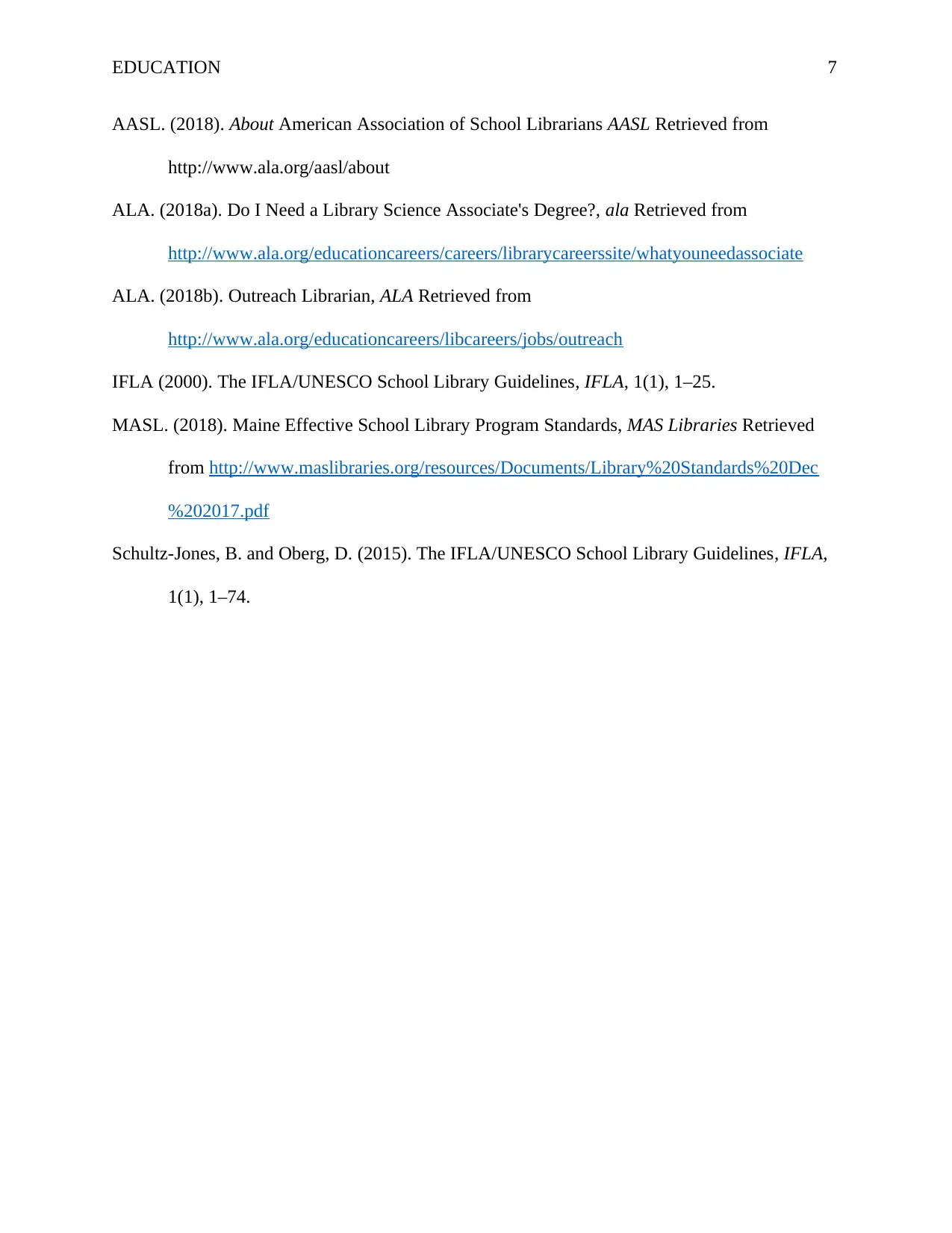
EDUCATION 7
AASL. (2018). About American Association of School Librarians AASL Retrieved from
http://www.ala.org/aasl/about
ALA. (2018a). Do I Need a Library Science Associate's Degree?, ala Retrieved from
http://www.ala.org/educationcareers/careers/librarycareerssite/whatyouneedassociate
ALA. (2018b). Outreach Librarian, ALA Retrieved from
http://www.ala.org/educationcareers/libcareers/jobs/outreach
IFLA (2000). The IFLA/UNESCO School Library Guidelines, IFLA, 1(1), 1–25.
MASL. (2018). Maine Effective School Library Program Standards, MAS Libraries Retrieved
from http://www.maslibraries.org/resources/Documents/Library%20Standards%20Dec
%202017.pdf
Schultz-Jones, B. and Oberg, D. (2015). The IFLA/UNESCO School Library Guidelines, IFLA,
1(1), 1–74.
AASL. (2018). About American Association of School Librarians AASL Retrieved from
http://www.ala.org/aasl/about
ALA. (2018a). Do I Need a Library Science Associate's Degree?, ala Retrieved from
http://www.ala.org/educationcareers/careers/librarycareerssite/whatyouneedassociate
ALA. (2018b). Outreach Librarian, ALA Retrieved from
http://www.ala.org/educationcareers/libcareers/jobs/outreach
IFLA (2000). The IFLA/UNESCO School Library Guidelines, IFLA, 1(1), 1–25.
MASL. (2018). Maine Effective School Library Program Standards, MAS Libraries Retrieved
from http://www.maslibraries.org/resources/Documents/Library%20Standards%20Dec
%202017.pdf
Schultz-Jones, B. and Oberg, D. (2015). The IFLA/UNESCO School Library Guidelines, IFLA,
1(1), 1–74.
1 out of 7
Related Documents
Your All-in-One AI-Powered Toolkit for Academic Success.
+13062052269
info@desklib.com
Available 24*7 on WhatsApp / Email
![[object Object]](/_next/static/media/star-bottom.7253800d.svg)
Unlock your academic potential
Copyright © 2020–2025 A2Z Services. All Rights Reserved. Developed and managed by ZUCOL.





